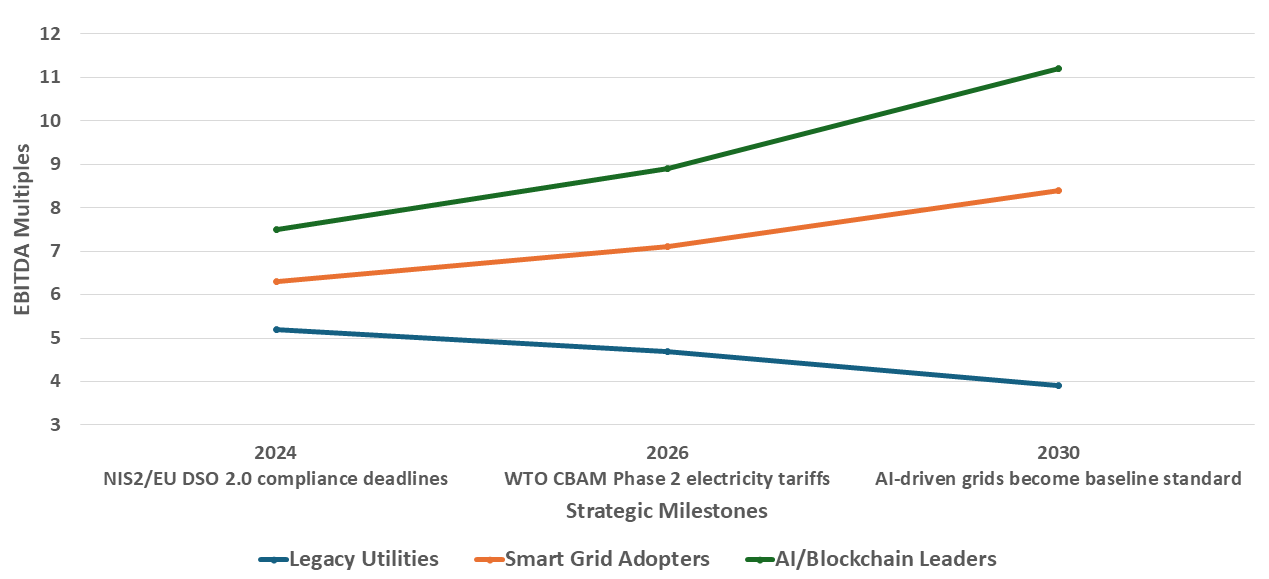Key Takeaways for Senior Executives
-
-
- The smart grid is no longer optional – regulatory pressures, aging infrastructure, and renewable integration mandates demand immediate action.
- Investments are shifting from pilots to full-scale deployments, with North America and Asia-Pacific leading in capital commitments.
- Cybersecurity and interoperability remain critical roadblocks – firms that solve these challenges will dominate the next decade.
- The winners in this space will not just adopt technology but reshape their business models around distributed energy and AI-driven grid optimization.
-
Why This Matters Now
The energy sector faces its most consequential realignment since electrification. Traditional grid systems – designed for one-way power flow and predictable demand – are collapsing under the weight of electrification, renewables, and decentralized generation.
The Hard Numbers Driving Urgency
-
-
- USD 1.8 Trillion in global grid investments needed by 2030 to meet net-zero targets.
- Over 40% of transmission assets across major markets are beyond their 50-year lifespan.
- Smart grid technologies can reduce outage durations nearly by 30%, saving utilities up to USD 5 to 7 billion annually.
-
This isn’t about incremental upgrades. It’s about fundamentally rethinking grid architecture or risking obsolescence.
The coming 18 months will determine:
-
-
- Which utilities capture $420 billion in climate-aligned grid financing
- Whether emerging markets replicate India’s success (18% renewable integration via smart meters) or repeat billion dollars cyberattack losses
-

The Smart Grid Value Divide
Three Strategic Levers for Competitive Advantage
1. Modernize with Precision – Not Just for Technology’s Sake
Many utilities fall into the trap of “tech-first” deployments without aligning investments to core business outcomes.
What Leading Firms Are Doing:
-
-
- PSEG (U.S.) used AI-driven predictive maintenance to cut grid failures in two years.
- Enel (Italy) leveraged smart meters + dynamic pricing to reduce peak demand.
-
Our Recommendation:
-
-
- Start with high-impact, low-regret moves:
- Phase 1: Deploy AMI and real-time monitoring (ROI within 3 years).
- Phase 2: Integrate distributed energy resources (DERs) with grid-edge intelligence.
- Phase 3: Transition to autonomous self-healing networks.
- Start with high-impact, low-regret moves:
-
2. Turn Cybersecurity from a Cost Center into a Differentiator
Cyber threats aren’t just operational risks – they’re existential.
The Reality:
-
-
- Energy is now the first target for cyberattacks, surpassing finance.
- Less than 1 in 10 utilities worldwide meet Tier 4 cybersecurity readiness under either NIST, IEC 62443, or EU NIS2 standards.
-
Winning Playbook:
-
-
- Embed security into grid design (zero-trust architecture).
- Partner with defense-tech firms (e.g., Dragos, Claroty) for OT-specific solutions.
- Use cyber resilience as a regulatory bargaining chip – demonstrate compliance ahead of mandates.
-
3. Monetize the Data – Beyond Basic Grid Optimization
Most utilities treat smart grid data as an operational tool. The real value lies in commercializing it.
Proven Models:
-
-
- Demand Response as a Service
- Grid analytics for renewable developers (e.g., feeding real-time congestion data to wind farms).
- White-labeling DER management platforms for municipal utilities.
-
Our Take:
If you’re not extracting at least USD 2 to 5 million per year in incremental revenue from grid data, you’re leaving money on the table.
The Global Smart Grid Divide: How Grid Modernization Will Reshape Regional Energy Leadership
The smart grid revolution is unfolding at starkly different speeds across global markets – creating first-mover advantages for some and existential risks for others. Here’s how regional strategies diverge:
1. The Three-Tiered Global Landscape
|
Region |
Strategic Posture | Key Differentiator | Valuation Impact |
|
North America |
Tech-led modernization | Private capital + AI integration | 8-10x EBITDA (DER-heavy utilities) |
| Europe | Regulation-driven overhaul | Cyber-secure, hydrogen-ready grids |
15-20% premium for TSOs with EU DSO 2.0 compliance |
|
Asia |
Leapfrog deployment | State-backed ultra-HVDC + IoT saturation | 30% higher capex recovery in India/ASEAN tariffs |
| Global South | Aid-funded patchwork solutions | Off-grid hybrid systems |
Stranded asset risks up to 40% of grid investments |
2. The Make-or-Break Factors By Region
-
-
- EMEA’s Cybersecurity Mandates: EU’s NIS2 Directive forces €125 billion in grid hardening by 2027 – non-compliant operators face market exclusion.
- Asia’s State Capitalism Advantage: China’s $170 billion Grid Modernization Plan deploys 5G-enabled sensors at 1/3 the cost of Western equivalents.
- Africa’s Bypass Opportunity: Kenyan and Nigerian utilities are skipping traditional SCADA for blockchain-minimalist grids, cutting deployment costs by 60%.
-
3. The 2025 Inflection Point
By next year:
-
-
- First-mover markets (Germany, Texas, Zhejiang) will achieve <2% grid losses vs. 8-12% global average
- Laggard regions face dual crises: 25% higher cost of capital + WTO carbon border taxes on exported electricity
-
Strategic Imperative: Utilities must now choose between:
-
-
- Becoming regional champions
- Commoditized grid operators trapped in regulated returns
-
Immediate Actions for Global Players:
-
-
- Map your exposure to the USD 2 Trillion in grid subsidies flowing to 15 priority markets
- Preemptively restructure legacy cross-border interconnects before EU/ASEAN carbon rules take effect
- Develop dual-track systems – Western-grade security for home markets, lean solutions for Global South JVs
-
The Boardroom Question: How Much Should We Invest and Where?
Prioritizing Capital Allocation
|
Investment Area |
Typical Capex | Payback Period |
Strategic Value |
|
AMI & Smart Meters |
$50-150 million (per 1 million meters) | 3-5 years |
Regulatory compliance, customer insights |
|
Distribution Automation |
$20-80 million (regional roll-out) | 4-7 years |
Outage reduction, DER integration |
|
Cybersecurity Overhaul |
$10-30 million (enterprise-wide) | 2-4 years |
Risk mitigation, regulatory alignment |
| AI/ML Grid Optimization | $5-15 million (pilot to scale) | 1-3 years |
Efficiency gains, predictive capacity |
Our Advice:
-
-
- Under $500 million revenue: Focus on AMI + targeted automation (80% of benefits at 20% cost).
- $500 million to $2 billion revenue: Add cybersecurity + AI pilots.
- $2 billion+ revenue: Go all-in on DER monetization and microgrids.
-
Conclusion: Turning Smart Grid Investments into Competitive Advantage
The smart grid transition is no longer a question of if but how fast and how strategically organizations execute. The coming decade will separate winners – those who leverage smart infrastructure to drive revenue and resilience – from those burdened by stranded assets and regulatory penalties.
Key Takeaways for Leadership Teams
-
-
- Prioritize High-Impact Pilots: Focus on AI-driven grid optimization and cybersecurity hardening to achieve quick wins while scaling long-term infrastructure upgrades.
- Monetize Data Now: Unlock new revenue streams by commercializing grid analytics, demand-response programs, and DER integration services.
- Future-Proof Regulatory Compliance: Proactively align with evolving cybersecurity and decarbonization mandates to avoid costly penalties.
- Reevaluate Asset Portfolios: Identify and modernize high-risk infrastructure before depreciation erodes shareholder value.
-
The time for incremental upgrades is over. Leading utilities are already treating smart grids as profit engines, not just cost centers.
Contact our energy practice to pressure-test your smart grid strategy against 2030 market realities.



